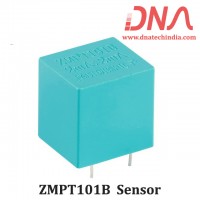Capacitors in Series |
|
Capacitors are said to be connected together "in series" when they are effectively "daisy chained" together in a single line. The charging current (ic) flowing through the capacitors is THE SAME for all capacitors as it only has one path to follow and iT = i1 = i2 = i3 etc. Then, Capacitors in Series all have the same current so each capacitor stores the same amount of charge regardless of its capacitance. This is because the charge stored by a plate of any one capacitor must have come from the plate of its adjacent capacitor therefore, |
|
QT = Q1 = Q2 = Q3 ....etc |
|
In the following circuit, capacitors, C1, C2 and C3 are all connected together in a series branch between points A and B. |
|
|
|
|
| In the previous parallel circuit we saw that the total capacitance, CT of the circuit was equal to the sum of all the individual capacitors added together. In a series connected circuit however, the total or equivalent capacitance CT is calculated differently. The voltage drop across each capacitor will be different depending upon the values of the individual capacitances. Then by applying Kirchoff's Voltage Law, (KVL) to the above circuit, we get: |
|
|
|
Since Q = CV or V = Q/C, substituting Q/C for each capacitor voltage VC in the above KVL equation gives us |
|
|
|
dividing each term through by Q gives |
|
|
Series Capacitors Equation |
|
|
| When adding together Capacitors in Series, the reciprocal (1/C) of the individual capacitors are all added together (just like resistors in parallel) instead of the capacitances themselves. Then the total value for capacitors in series equals the reciprocal of the sum of the reciprocals of the individual capacitances. |
|
|
Example No1 |
|
Taking the three capacitor values from the above example, we can calculate the total circuit capacitance for the three capacitors in series as: |
|
|
|
One important point to remember about capacitors that are connected together in a series configuration, is that the total circuit capacitance (CT) of any number of capacitors connected together in series will always be LESS than the value of the smallest capacitor in the series and in our example above CT = 0.055uF were as the value of the smallest capacitor is only 0.1uF. |
|
This reciprocal method of calculation can be used for calculating any number of capacitors connected together in a single series network. If however, there are only two capacitors in series, then a much simpler and quicker formula can be used and is given as: |
|
|
|
|
Example No2 |
|
Find the overall capacitance and the individual voltage drops across the following sets of two capacitors in series when connected to a 12V d.c. supply. |
|
a) two capacitors each with a capacitance of 47nF b) one capacitor of 470nF connected in series to a capacitor of 1uF |
|
a) Total Capacitance, |
|
|
|
Voltage drop across the capacitors, |
|
|
|
b) Total Capacitance, |
|
|
|
Voltage drop across Capacitors, |
|
|
|
So, the total or equivalent capacitance, CT of a circuit containing Capacitors in Series is the reciprical of the sum of the reciprocals of all of the individual capacitances added together. |
|
In the next tutorial about Capacitors, we will look at the behaviour of capacitors that are connected to a sinusoidal AC supply |
|
|
| Reproduced with permission from Wayne Storr |
| ( http://www.electronics-tutorials.ws/capacitor/cap_7.html ) |













